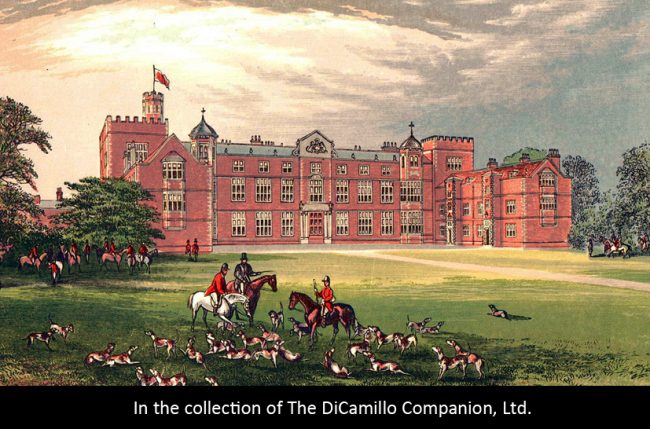
The house from "Morris's Views of Seats," circa 1875.

The skeleton of the 58-foot-long male sperm whale at Burton Constable that was seen by Herman Melville, who described it in his famous 1851 novel, "Moby Dick."
Earlier Houses: There was at least one earlier house on, or near, the site of the current house.
Built / Designed For: John Constable or Sir Henry Constable
House & Family History: The National Heritage Memorial Fund contributed £5,417,284 in 1992 toward the establishment of the charitable trust that today owns the house and grounds.
Collections: Burton Constable is noted for its fine collection of Chippendale furniture. The National Heritage Memorial Fund allotment of £553,500 purchased some of the house contents between 1988 and 1990; the last member of the Constable family to live in the house donated the remaining contents and helped form an endowment for charitable trust. Jeremiah Hargrave's pair of sarcophagus wine cisterns, obtained for Burton Constable in 1769 by William Constable, was purchased by Leeds City Art Galleries for Temple Newsam for £120,000. Giacomo Raffaelli and Giuseppe Leonardi's pair of Italian marble and giltwood tables, purchased for Burton Constable by Sir Clifford Constable when in Rome, circa 1815, were purchased by the Leeds City Art Galleries for Temple Newsam for £565,000.
Garden & Outbuildings: Between 1788 and 1789 Thomas Atkinson converted an existing greenhouse into the orangery for William Constable. In 1825 the body of a 58-foot-long male sperm whale (see "Images" section) washed up at Tunstall, on the Holderness coast. By the 1830s this skeleton of the world's largest toothed predator had been acquired by Sir Clifford Constable, who had the remains mounted in Burton Constable's parkland. It was here that it became an attraction that was viewed by writers, scientists, and tourists; included in that last category was Herman Melville, who described the scene in his famous 1851 novel, "Moby Dick."
Architect: Timothy Lightoler
Date: Circa 1757-68Architect: Lancelot Brown
Date: 1767-82Architect: James Wyatt
Date: 1776-86Architect: Thomas Atkinson
Date: 1773-89John Bernard (J.B.) Burke, published under the title of A Visitation of the Seats and Arms of the Noblemen and Gentlemen of Great Britain and Ireland, among other titles: 2.S. Vol. I, p. 89, 1854.
Country Life: XXI, 126, 1907. LXXII, 238, 266 plan, 1932. CLIX, 1476 [Furniture], 1622 [Furniture], 1976. Ivan Hall in May 13, 1982. CLXXI, 1114, 1198, 1278, 1358, 1982.
Title: Biographical Dictionary of British Architects, 1600-1840, A - SOFTBACK
Author: Colvin, Howard
Year Published: 1995
Reference: pg. 1114
Publisher: New Haven: Yale University Press
ISBN: 0300072074
Book Type: Softback
Title: Disintegration of a Heritage: Country Houses and their Collections, 1979-1992, The
Author: Sayer, Michael
Year Published: 1993
Publisher: Norfolk: Michael Russell (Publishing)
ISBN: 0859551970
Book Type: Hardback
House Listed: Grade I
Park Listed: Grade II*
Past Seat / Home of: SEATED AT CURRENT HOUSE: William Constable, 18th century; Sir Clifford Constable, 19th century; Constable family here from the 12th century until 1992.
Current Ownership Type: Charity / Nonprofit
Primary Current Ownership Use: Visitor Attraction
Ownership Details: Owned by the Burton Constable Foundation
House Open to Public: Yes
Phone: 01964-562-400
Fax: 01964-563-229
Email: [email protected]
Website: http://www.burtonconstable.com
Historic Houses Member: Yes